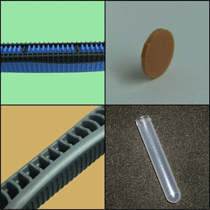An increasing number of plastics processors are taking advantage of multi-material processing machinery to help them shave time and costs off of projects, as well as to win more business. The resulting parts are popular with customers, but often also require automated assembly systems in a processor's plant meet specific product handling parameters and customer needs.
December 14, 2010
An increasing number of plastics processors are taking advantage of multi-material processing machinery to help them shave time and costs off of projects, as well as to win more business. The resulting parts are popular with customers, but often also require automated assembly systems in a processor's plant meet specific product handling parameters and customer needs.
|
Multi-material co-extruded and co-injection-molded components can present unique feeding, handling and assembly challenges. The Arthur G. Russell Company works to develop and manufacture automated systems that meet processors' output objectives without marring or scratching components. |
Helping solve the issues associated with of handling these parts is The Arthur G. Russell Company (Bristol, CT), which manufacturers bulk sorting and feeding solutions that can operate at a variety of speeds to facilitate the automated assembly of multi-material components.
"From time to time, we have been asked by existing and new customers to develop both slow- and high-speed solutions for automating the sorting or assembly of components that are co-molded or co-extruded using materials that offer some benefits to the end-user or downstream process, but do not lend themselves to traditional feeding and assembly methods. The trick from a manufacturing angle is to design adaptive feeding and handling systems that can accommodate the unique physical characteristics and material properties of the specific co-extruded or co-molded part," explains Steven Johnson, applications engineer at the company.
Advantages for using multiple materials can include performance-enhancements such as increasing core strength, achieving improved sound or vibration absorbency, reducing product weight; meeting sustainability objectives by including re-grind material; and achieving attention-grabbing consumer appeal. Because the variety of potential multi-material combination s great, typically each automation system manufactured for these applications is a bespoke one.
About the Author(s)
You May Also Like



